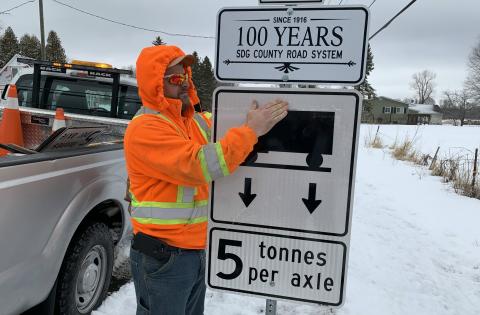
THE COUNTIES, Ontario – It’s still the middle of February, but thanks to some unseasonably mild conditions SDG Counties will begin its half-load season just a bit early.
Half-load season in our region will come into effect on Wednesday, Feb. 21 – a full three weeks ahead of schedule.
The reason is pretty evident when one checks the recent temperatures that we’ve experienced in our region. Despite some recent snow, this winter has been pretty accomodating thus far.
SDG Counties and its partners among local municipalities and the City of Cornwall will be limiting the weight of materials to five tonnes per axle on the weaker roads located throughout the region.
Roads that are subject to seasonal weight restrictions are identified with a sign. Half-loads will be enforced once signs are posted and will likely run into the early part of May – but the end date could change depending on weather conditions this spring.
Except the following locations, most roads within SDG are subject to half-load restrictions:
- South of Highway 401 on County Road Nos. 1, 14, 33 and 35.
- County Road 1 from French Settlement Road to Belmeade Road
- County Road 15 from County Road 2 to the southwest leg of County Road 36.
- County Road 44 from Highway No. 138 to 840m East of County Road 42
- County Road Nos. 31, 34, 43, 46
- County Road No. 2 from Leeds & Grenville boundary to the City of Cornwall boundary and from the City of Cornwall boundary to the Ontario/Quebec boundary.
Trevor Baker, SDG Counties’ operations manager, said half-load season is integral to the long-term sustainability of the road infrastructure – the largest municipal roads system in the entire province.
“These measures are important to the bottom line of SDG Counties, as well as the effective use of taxpayer dollars,” said Baker. “We allow for the transportation of goods across SDG Counties, while at the same time putting measures in place to protect the investment taxpayers have made in our infrastructure.”
Try to think of a road like a giant sandwich buried in the ground with layers that are important to the overall flavour of the road. When you add an extra ingredient – like water – your sandwich can become a mess. The base of the road begins at its deepest point with the sub-grade material, which is typically native material or imported fill. On top of this layer is aggregate material of varying sizes of crushed stone and other granulars that are packed into place. Finally, the whole thing is topped with asphalt.
The problem comes in the late winter and early spring when the heat of the sun can warm the asphalt base to several degrees above freezing, while the ambient air temperature can often be well below zero. As snow and ice melts, it can permeate the asphalt in areas. When that water refreezes, say after sunset or during an especially cold day, the ice and trapped water will weaken the strength of the road.
By restricting the amount of weight a vehicle carries, the damage to weakened roads can be mitigated.
